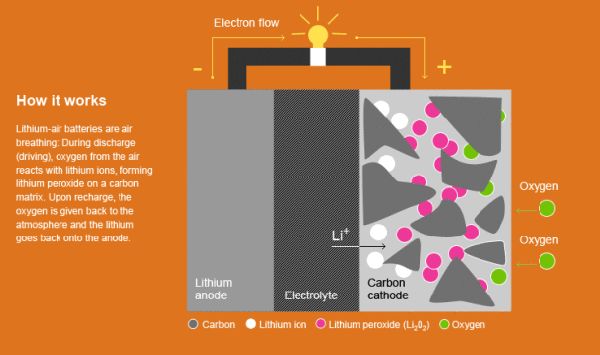IBM could be on the verge of achieving a breakthrough in battery technology that could give electric cars a 500 mile range, overcoming the range anxiety barrier to the adoption of electric cars. The air breathing battery has a lithium anode and a carbon matrix cathode. When the battery is delivering power or discharging, the carbon cathode absorbs oxygen from the air that reacts with lithium ions from the anode to deposit lithium peroxide in the matrix structure. When the battery is recharged, the oxygen is expelled back into the atmosphere and the lithium ions are deposited back into the anode. A prototype is expected to be ready in 2013 and the technology could get commercialized by 2020.

Lithium air battery technology is not new, having been spoken of as early as the 1990s. The discovery of nano materials technology in the 2000s led to renewed interest in the technology, as lithium air batteries can potentially have the same energy density as gasoline at around 13 kWH per kilogram. This is 5 to 10 times higher than the Lithium Ion batteries being currently used in electric cars. In other words, a lithium air battery would store at least 5 times the energy stored in a lithium ion battery of the same size or that the battery size could be substantially reduced. In electric cars the larger energy storage is of interest while in other battery powered appliances, the smaller size would be attractive.
The development of the lithium air battery technology has been hampered by several challenges. The lithium anode becomes explosive in the presence of water vapor from the air. This problem has been overcome by using sealed anodes with a ceramic barrier. The air breathing carbon cathode had the problem of getting clogged. This too has been overcome by creating matrix structures similar to the human lung that have multiple paths for the air flow so that the oxygen can take different paths through the structure. IBM also claims to have identified a new electrolyte that overcomes the problem of multiple deep charge discharge cycles. The electrolyte composition is confidential for the present.
The discovery of a 500 mile range battery would certainly accelerate the acceptance of electric cars. The limitation of range from 100 to 150 miles is a major deterrent in using an electric car for long distance inter city transits. Battery recharge stations are very few on interstate roads and the recharge process takes about 3 to 8 hours. The alternative of a hybrid car only partially solves the CO2 emissions problem. The long range battery coupled perhaps with battery swap could make electric vehicles the better choice as petroleum prices continue to climb.
Via: CNET




